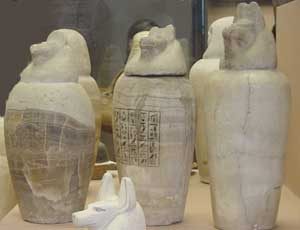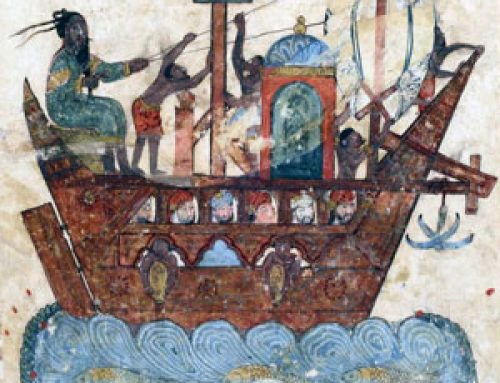
Canopic Jars from Egypt(Vatican Museum, Rome)
When people died in ancient Egypt, if they were rich enough, they paid to have their body made into a mummy. Mummification preserved your body for the afterlife.
What is a mummy?
Egypt: death and afterlife
More Egyptian religion
All our Ancient Egypt articles
Cleaning out your guts
In order to make you into a mummy, the undertakers had to take out your guts (otherwise you would rot). This was kind of like cleaning a fish. They took out your liver, your stomach and small intestine, your large intestine, and your lungs. (They left your heart inside your body, because people thought the heart was where your soul lived.)
What is a stomach?
What do lungs do?
How did hearts evolve?
Egyptian medicine and doctors
Putting them in canopic jars

Mummy from the New Kingdom(Vatican Museum, Rome)
But what should they do with the guts? You might need them in the afterlife, too. So the undertakers put your guts in jars, each organ in its own jar. We call these canopic jars, and we find thousands of them in Egyptian graves.
The gods of canopic jars

Isis and her baby Horus (Middle Kingdom, now in the Metropolitan Museum of Art, New York)
Each kind of organ had its own god and goddess to protect it. The jars showed which god was responsible. These gods were the sons of the Egyptian god of protection and rebirth, Horus. Your liver went in Imsety’s jar with the human head on it, and Isis protected that jar.
Who is Horus?
More about Isis
Your lungs went in Hapi’s jar with the baboon head on it, and Nephthys protected that jar. Next your stomach went in Duamutef’s jar with the jackal head on it, and Neith protected it, and finally your large intestine went in Qebehsenuef’s jar with a hawk head on it, and Serket protected it.
Learn by doing: Egyptian afterlife project
More about ancient Egyptian mummies
And more about the Egyptian god Horus
Bibliography and further reading about mummification:
Gods and Goddesses of Ancient Egypt, by Leonard Fisher (1999). For younger kids.
Isis and Osiris, by Geraldine Harris (1997). A retelling of the story for kids.
The Egypt Game (Yearling Newbery), by Zilpha Keatley Snyder (reprinted 1985). A great kids’ story about kids who pretend to be Egyptian gods and goddesses.
Religion in Ancient Egypt: Gods, Myths, and Personal Practice, by John Baines, David Silverman, and Leonard Lesko (1991). Pretty hard going, but it will tell you everything you need to know about Egyptian religion.
Isis in the Ancient World, by R.E. Witt (1997). Mostly about the spread of Isis worship to Greece and the Roman Empire.


